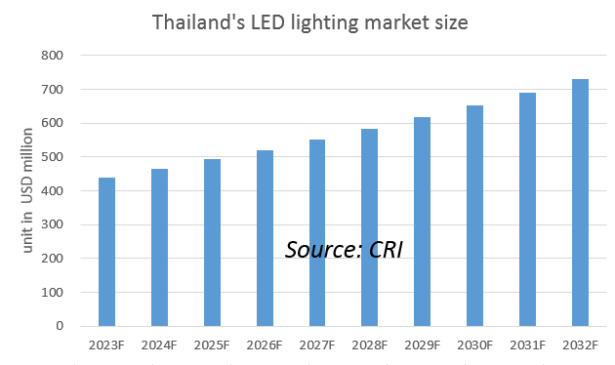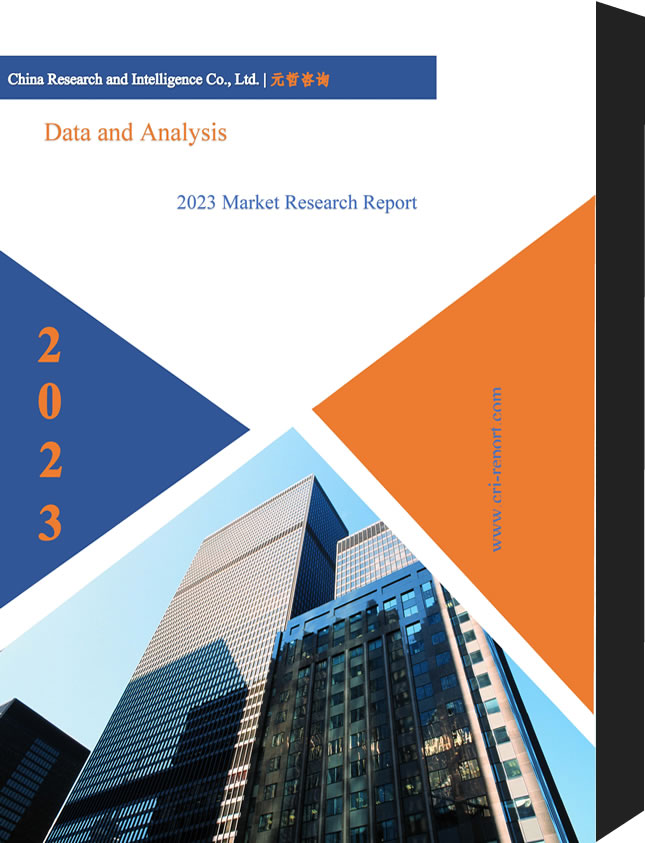Description
Southeast Asia LED Lighting Industry Overview
With the rapid economic growth in Southeast Asia, the rising demand for lighting in residential life and industrial and commercial scenes has contributed to the growth of the LED lighting market in Southeast Asia.
According to CRI analysis, the Southeast Asia LED lighting market size has exceeded US$3 billion in 2022 and is growing.
Since 2016, electronic equipment products can be sold in other ASEAN countries after obtaining certification in one of the countries in ASEAN. The implementation of the unified standard has undoubtedly brought significant development opportunities to the Southeast Asian market. According to CRI’s analysis, for LED lighting companies, there is no need for multiple standard certifications to enter the Southeast Asian market, which directly saves export costs and time. For local markets and consumers, the implementation of unified standards can help improve the quality and standards of LED lighting products, thereby allowing more consumers to accept LED lighting.

According to CRI’s analysis, there are fewer local LED lighting-related enterprises in Southeast Asia, so Southeast Asian LED lighting products are very dependent on imports, especially from China. Due to the low per capita income in Southeast Asia, the Southeast Asian market is therefore more sensitive to the price of LED lighting products, and CRI suggests that LED lighting companies should give priority to low- and medium-priced products when entering the Southeast Asian market. It is expected that in 2023-2032, there will be more LED lighting companies to build factories in Southeast Asia.
Southeast Asia in this report includes 10 countries: Singapore, Thailand, Philippines, Malaysia, Indonesia, Vietnam, Myanmar, Brunei, Laos and Cambodia. With a total population of over 600 million by the end of 2021, Southeast Asia has an overall economic growth rate higher than the global average and is one of the key drivers of future global economic growth.
According to CRI’s analysis, the economic levels of the 10 Southeast Asian countries vary greatly, with Singapore being the only developed country with a per capita GDP of about US$73,000 in 2021. While Myanmar and Cambodia will have a GDP per capita of less than US$2,000 in 2021. The population and minimum wage levels of each country also vary greatly. Brunei, which has the smallest population, will have a total population of less than 500,000 people in 2021, while Indonesia, which has the largest population, will have a population of about 275 million people in 2021.
CRI expects that the LED lighting industry in Southeast Asia will maintain growth from 2023-2032. On the one hand, Southeast Asia lighting market has a lot of room for development. On the other hand, Southeast Asian governments support the development of LED lighting industry, which attracts more LED lighting related companies to build factories in Southeast Asia and promote the development of Southeast Asian LED lighting industry.
Topics covered:
- Southeast Asia LED Lighting Industry Status and Major Sources in 2018-2022
- What is the Impact of COVID-19 on Southeast Asia LED Lighting Industry?
- Which Companies are the Major Players in Southeast Asia LED Lighting Industry Market and What are their Competitive Benchmarks?
- Key Drivers and Market Opportunities in Southeast Asia LED Lighting Industry
- What are the Key Drivers, Challenges, and Opportunities for Southeast Asia LED Lighting Industry during 2023-2032?
- What is the Expected Revenue of Southeast Asia LED Lighting Industry during 2023-2032?
- What are the Strategies Adopted by the Key Players in the Market to Increase Their Market Share in the Industry?
- What are the Competitive Advantages of the Major Players in Southeast Asia LED Lighting Industry Market?
- Which Segment of Southeast Asia LED Lighting Industry is Expected to Dominate the Market in 2032?
- What are the Major Adverse Factors Facing Southeast Asia LED Lighting Industry?
Table of Contents
1 Singapore LED Lighting Industry Analysis
1.1 Singapore LED Lighting Industry Development Environment
1.1.1 Geography
1.1.2 Population
1.1.3 Economy
1.1.4 Minimum Wage in Singapore
1.2 2018-2022 Singapore LED Lighting Industry Operation Status
1.2.1 Production Status
1.2.2 Sales Status
1.2.3 Import and Export Status
1.3 Analysis of Major LED Lighting Companies in Singapore
2 Thailand LED Lighting Industry Analysis
2.1 Thailand LED Lighting Industry Development Environment
2.1.1 Geography
2.1.2 Population
2.1.3 Economy
2.1.4 Thailand Minimum Wage
2.2 Thailand LED Lighting Industry Operation Status 2018-2022
2.2.1 Production Status
2.2.2 Sales Status
2.2.3 Import and Export Status
2.3 Analysis of Major LED Lighting Companies in Thailand
3 Analysis of LED Lighting Industry in the Philippines
3.1 Development Environment of LED Lighting Industry in the Philippines
3.1.1 Geography
3.1.2 Population
3.1.3 Economy
3.1.4 Minimum Wage in the Philippines
3.2 LED Lighting Industry Operation in the Philippines 2018-2022
3.2.1 Production Status
3.2.2 Sales Status
3.2.3 Import and Export Status
3.3 Analysis of Major LED Lighting Companies in the Philippines
4 Malaysia LED Lighting Industry Analysis
4.1 Malaysia LED Lighting Industry Development Environment
4.1.1 Geography
4.1.2 Population
4.1.3 Economy
4.1.4 Minimum Wage in Malaysia
4.2 Malaysia LED Lighting Industry Operation Status 2018-2022
4.2.1 Production Status
4.2.2 Sales Status
4.2.3 Import and Export Status
4.3 Analysis of Major LED Lighting Companies in Malaysia
5 Indonesia LED Lighting Industry Analysis
5.1 Indonesia LED Lighting Industry Development Environment
5.1.1 Geography
5.1.2 Population
5.1.3 Economy
5.1.4 Indonesia Minimum Wage
5.2 2018-2022 Indonesia LED Lighting Industry Operation Status
5.2.1 Production Status
5.2.2 Sales Status
5.2.3 Import and Export Status
5.3 Analysis of Major LED Lighting Companies in Indonesia
6 Vietnam LED Lighting Industry Analysis
6.1 Vietnam LED Lighting Industry Development Environment
6.1.1 Geography
6.1.2 Population
6.1.3 Economy
6.1.4 Vietnam’s Minimum Wage
6.2 2018-2022 Vietnam LED Lighting Industry Operation Situation
6.2.1 Production Status
6.2.2 Sales Status
6.2.3 Import and Export Status
6.3 Analysis of Major LED Lighting Companies in Vietnam
7 Myanmar LED Lighting Industry Analysis
7.1 Myanmar LED Lighting Industry Development Environment
7.1.1 Geography
7.1.2 Population
7.1.3 Economy
7.1.4 Myanmar Minimum Wage
7.2 Myanmar LED Lighting Industry Operation Status 2018-2022
7.2.1 Production Status
7.2.2 Sales Status
7.2.3 Import and Export Status
7.3 Analysis of Major LED Lighting Companies in Myanmar
8 Brunei LED Lighting Industry Analysis
8.1 Brunei LED Lighting Industry Development Environment
8.1.1 Geography
8.1.2 Population
8.1.3 Economy
8.1.4 Brunei Minimum Wage
8.2 2018-2022 Brunei LED Lighting Industry Operation Situation
8.2.1 Production Status
8.2.2 Sales Status
8.2.3 Import and Export Status
8.3 Analysis of Major LED Lighting Enterprises in Brunei
9 Laos LED Lighting Industry Analysis
9.1 Laos LED Lighting Industry Development Environment
9.1.1 Geography
9.1.2 Population
9.1.3 Economy
9.1.4 Minimum Wage in Laos
9.2 Operation of LED Lighting Industry in Laos 2018-2022
9.2.1 Production Status
9.2.2 Sales Status
9.2.3 Import and Export Status
9.3 Laos Major LED Lighting Companies Analysis
10 Cambodia LED Lighting Industry Analysis
10.1 Cambodia LED Lighting Industry Development Environment
10.1.1 Geography
10.1.2 Population
10.1.3 Economy
10.1.4 Minimum Wage in Cambodia
10.2 Cambodia LED Lighting Industry Operation Status 2018-2022
10.2.1 Production Status
10.2.2 Sales Status
10.2.3 Import and Export Status
10.3 Analysis of Major LED Lighting Companies in Cambodia
11 Southeast Asia LED Lighting Industry Outlook 2023-2032
11.1 Southeast Asia LED Lighting Industry Development Influencing Factors Analysis
11.1.1 Favorable Factors
11.1.2 Unfavorable Factors
11.2 Southeast Asia LED Lighting Industry Revenue Forecast 2023-2032
11.3 Southeast Asia LED Lighting Industry Sales Analysis 2023-2032
11.4 COVID -19 Epidemic Impact on LED Lighting Industry




Reviews
There are no reviews yet.